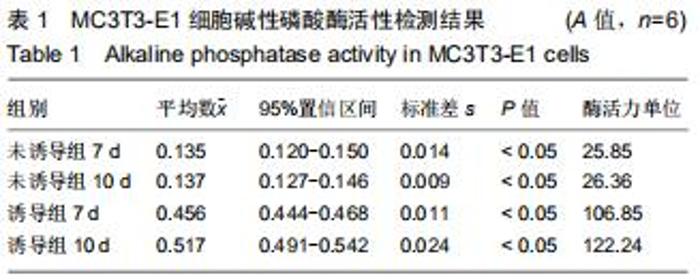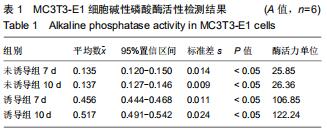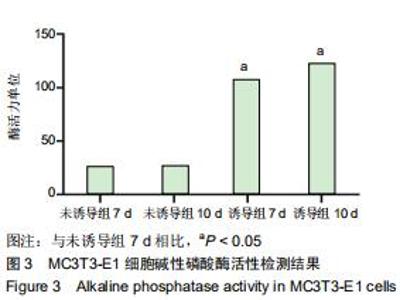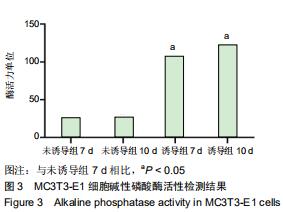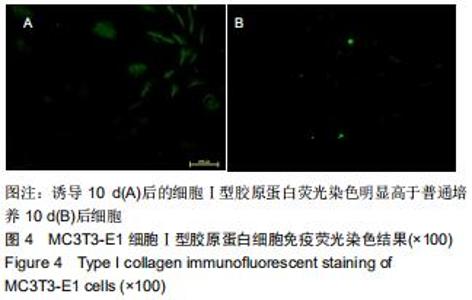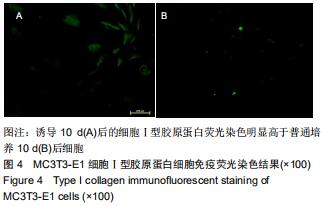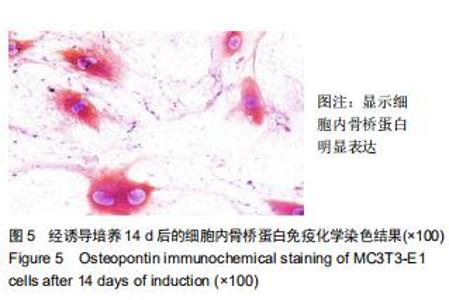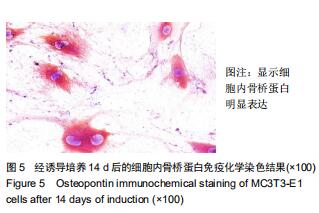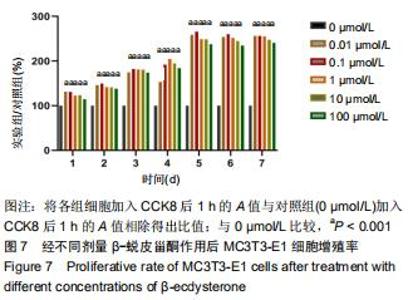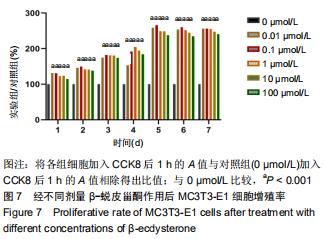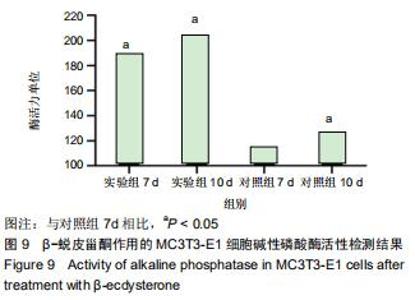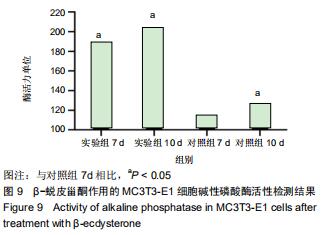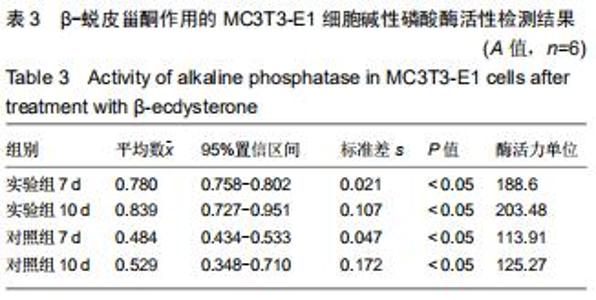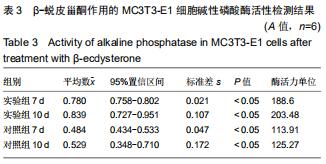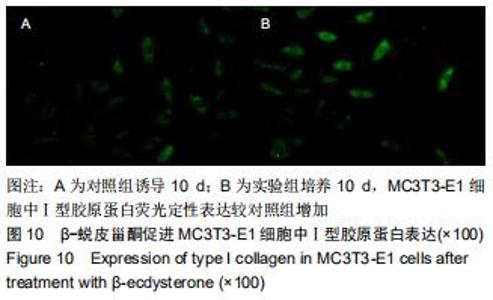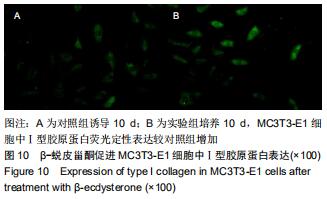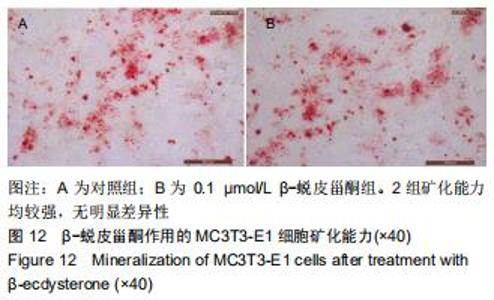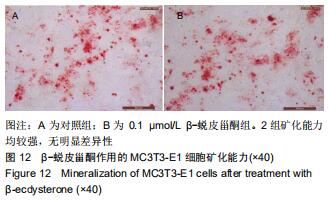Chinese Journal of Tissue Engineering Research ›› 2020, Vol. 24 ›› Issue (29): 4605-4612.doi: 10.3969/j.issn.2095-4344.2781
Previous Articles Next Articles
Beta-ecdysterone promotes in vitro proliferation and osteogenic differentiation of MC3T3-E1 cells
Yan Caiping1, Chen Lu1, Deng Changgong1, Chen Qian1, Jiang Ke1, Yi Yuanyuan2, Li Yuling1
- 1Department of Orthopedics, 2Department of Neurosurgery, Affiliated Hospital of North Sichuan Medical College, Nanchong 637000, Sichuan Province, China
-
Received:2020-01-15Revised:2020-01-18Accepted:2020-03-04Online:2020-10-18Published:2020-09-11 -
Contact:Li Yuling, MD, Attending physician, Department of Orthopedics, Affiliated Hospital of North Sichuan Medical College, Nanchong 637000, Sichuan Province, China -
About author:Yan Caiping, Master candidate, Physician, Department of Orthopedics, Affiliated Hospital of North Sichuan Medical College, Nanchong 637000, Sichuan Province, China -
Supported by:the General Scientific Research Project of Sichuan Provincial Department of Science and Technology, No. 2018JY0250
CLC Number:
Cite this article
Yan Caiping, Chen Lu, Deng Changgong, Chen Qian, Jiang Ke, Yi Yuanyuan, Li Yuling. Beta-ecdysterone promotes in vitro proliferation and osteogenic differentiation of MC3T3-E1 cells[J]. Chinese Journal of Tissue Engineering Research, 2020, 24(29): 4605-4612.
share this article
|
[1] POSA F, DI BENEDETOO A, CAVALCANTI-ADAM EA, et al. Vitamin D Promotes MSC Osteogenic Differentiation Stimulating Cell Adhesion and αVβ3 Expression.Stem Cells Int. 2018;2018: 6958713.
[2] YAO H, XUE J, WANG Q, et al. Glucosamine-modified polyethylene glycol hydrogel-mediated chondrogenic differentiation of human mesenchymal stem cells.Mat Sci Eng C-Mater.2017;79:661-670.
[3] KUSUMA S, GERECHT S. Derivation of endothelial cells and pericytes from human pluripotent stem cells.Methods Mol Biol. 2016;1307:213‐222.
[4] BERESFORD JN, BENNETT JH, DEVLIN C, et al. Evidence for an inverse relationship between the differentiation of adipocytic and osteogenic cells in rat marrow stromal cell cultures.J Cell Sci. 1992;102 (Pt 2):341-351.
[5] NUTTALL ME, GIMBLE JM. Is there a therapeutic opportunity to either prevent or treat osteopenic disorders by inhibiting marrow adipogenesis? Bone. 2000;27(2):177-184.
[6] NILSSON O, WEISE M, LANDMAN EB, et al. Evidence that estrogen hastens epiphyseal fusion and cessation of longitudinal bone growth by irreversibly depleting the number of resting zone progenitor cells in female rabbits.Endocrinology.2014;155(8): 2892- 2899.
[7] MANSON JE, HSIA J, JOHNSON KC, et al. Estrogen plus progestin and the risk of coronary heart disease. N Engl J Med. 2003;349: 523-534.
[8] KAPUR P, WUTTKE W, JARRY H, et al. Beneficial effects of beta-ED-Sysone on the joint, epiphyseal cartilage tissue and trabecular bone in ovariectomized rats. Phytomedicine. 2010; 17(5): 350-355.
[9] OTAKA T, OKUI S, UCHIYAMA M, et al. Stimulati on of protein synthesis in mouse liver by ecdysterone. Chem Pharm Bull.1969; 17(1): 75-81.
[10] OTAKA T, UCHIYAMA M. Stimulatory effect of ecdysterone on RNA synthesis in mouse liver. Chem Pharm Bull.1969;17(9): 1883-1888.
[11] YOSHIDA T, OTAKA T, UCHIYAMA M, et al. Eff ect of ecdysterone on hyperglycemia in expermental animals. Biochem Pharm. 1971; 20(12): 3263-3268.
[12] 松田弘幸,河场享子,山本幸生,他. Ecdysteroneの实验的家兔动脉硬化症におよぼす影响[J].日药理志,1974,70(3):325-339.
[13] TAKEI M, ENDO K, NISHIMOTO N, et al. Effect of ecdysterone on histamine release from rat peritoneal mast cells.J Pharm Sci. 1991;80( 4): 309-310.
[14] GAO L, CAI G, SHI X. Beta-ecdysterone induces osteogenic differentiation in mouse mesenchymal stem cells and relieves osteoporosis.Biol Pharm Bull. 2008;31(12):2245-2249.
[15] DAI WW, WANG LB, JIN GQ, et al. Beta-Ecdysone Protects Mouse Osteoblasts from Glucocorticoid-Induced Apoptosis In Vitro.Planta Med. 2017;83(11):888-894.
[16] TANG YH, YUE ZS, LI GS, et al. Effect of β‑ecdysterone on glucocorticoid‑induced apoptosis and autophagy in osteoblasts. Mol Med Rep. 2018;17(1):158-164.
[17] TANG YH, YUE ZS, XIN DW, et al. β‑Ecdysterone promotes autophagy and inhibits apoptosis in osteoporotic ratsMol Med Rep. 2018;17(1):1591-1598.
[18] ABIRAMASUNDARI G, MOHAN GOWDA CM, SREEPRIYA M. Selective Estrogen Receptor Modulator and prostimulatory effects of phytoestrogen β-ecdysone in Tinospora cordifolia on osteoblast cells.J Ayurveda Integr Med. 2018;9(3):161-168.
[19] ZHANG X, XU X, XU T, et al.β-Ecdysterone Suppresses Interleukin- 1β-Induced Apoptosis and Inflammation in Rat Chondrocytes via Inhibition of NF-κB Signaling Pathway.Drug Dev Res. 2014;75(3):195-201.
[20] KUNIMATSU R, GUNJI H, TSUKA Y, et al. Effects of high-frequency Near-infrared diode laser irradiation on the proliferation and migration of mouse calvarial osteoblasts.Lasers Med Sci.2018;33(5):959-966.
[21] GAL TJ, MUNOZ-ANTONIA T, MUR-CACHO CA, et al. Radiation effects on osteoblasts in vitro - a potential role in osteoradionecrosis. Arch Otolaryngol Head Neck Surg.2000; 126(9):1124-1128.
[22] 赵秀敏,艾红军,常新.成骨细胞和破骨细胞的传导通路和相关因子[J].中国实用口腔科杂志,2009,2(3):176-179.
[23] 李彬,张柳.RUNX2与骨代谢的调控[J].中国骨质疏松杂志,2009, 15(1):63-67.
[24] 徐成峰,胡大海,赵周婷,等.兔骨髓间充质干细胞体外分离培养及多向诱导分化[J].中国组织工程研究与临床康复,2010,14(6): 1002-1005.
[25] ZHANG L, HU Y, SUN,CY, et al. Lentiviral sh RNA silencing of BDNF inhibits in vivo multiple myeloma growth and angiogenesis via down-regulated stroma-derived VEGF expression in the bone marrow milieu.Cancer Sci.2010;101(5):1117-1124.
[26] 张贤,朱丽华,钱晓伟,等.杜仲醇提取物诱导骨髓间充质干细胞成骨分化中的Wnt信号途径[J].中国组织工程研究,2012,16(45): 8520-8523.
[27] ZHOU PR, LIU HJ, LIAO EY, et al. LRP5 polymorphisms and response to alendronate treatment in Chinese postmenopausal women with osteoporosis. Pharmacogenomics. 2014;15(6): 821-831.
[28] LIU TM, LEE EH. Transcriptional Regulatory Cascades in Runx2-Dependent Bone Development.Tissue Eng Part B Rev. 2013;19(3):254-263.
[29] JIAN CX, LIU XF, HU J, et al. 20-hydroxyecdysone-induced bone morphogenetic protein-2-dependent osteogenic differentiation through the ERK pathway in human periodontal ligament stem cell.Eur J Pharmacol. 2013;698(1-3):48-56.
[30] SEIDLOVA-WUTTKE D, CHRISTEL D, KAPUR P, et al. Beta-ecdysone has bone protective but no estrogenic effects in ovariectomized rats.Phytomedicine.2010;17: 884-889.
[31] KAPUR P, WUTTKE W, JARRY H, et al. Beneficial effects of beta-Ecdysone on the joint, epiphyseal cartilage tissue and trabecular bone in ovariectomized rats.Phytomedicine.2010; 17: 350-355. |
| [1] | Geng Yao, Yin Zhiliang, Li Xingping, Xiao Dongqin, Hou Weiguang. Role of hsa-miRNA-223-3p in regulating osteogenic differentiation of human bone marrow mesenchymal stem cells [J]. Chinese Journal of Tissue Engineering Research, 2021, 25(7): 1008-1013. |
| [2] | Liu Bo, Chen Xianghe, Yang Kang, Yu Huilin, Lu Pengcheng. Mechanism of DNA methylation in exercise intervention for osteoporosis [J]. Chinese Journal of Tissue Engineering Research, 2021, 25(5): 791-797. |
| [3] | Ye Haimin, Ding Linghua, Kong Weihao, Huang Zutai, Xiong Long. Role and mechanism of hierarchical microchanneled bone scaffolds in promoting osteogenesis and angiogenesis [J]. Chinese Journal of Tissue Engineering Research, 2021, 25(4): 621-625. |
| [4] | Zhang Lishu, Liu Anqi, He Xiaoning, Jin Yan, Li Bei, Jin Fang. Alpl gene affects the therapeutic effect of bone marrow mesenchymal stem cells on ulcerative colitis [J]. Chinese Journal of Tissue Engineering Research, 2021, 25(25): 3970-3975. |
| [5] | Zhou Wu, Wang Binping, Wang Yawen, Cheng Yanan, Huang Xieshan. Transforming growth factor beta combined with bone morphogenetic protein-2 induces the proliferation and differentiation of mouse MC3T3-E1 cells [J]. Chinese Journal of Tissue Engineering Research, 2021, 25(23): 3630-3635. |
| [6] | Liu Keke, Duan Xin, Ma Xiangrui, Zhang Yuntao. Effect of cinnamaldehyde on osteoblasts in high glucose environment with the electrospinning membrane as a carrier [J]. Chinese Journal of Tissue Engineering Research, 2021, 25(22): 3500-3504. |
| [7] | Jiang Shengyuan, Li Dan, Jiang Jianhao, Shang-you Yang, Yang Shuye. Biological response of Co2+ to preosteoblasts during aseptic loosening of the prosthesis [J]. Chinese Journal of Tissue Engineering Research, 2021, 25(21): 3292-3299. |
| [8] | Li Zhen, Huang Yonghui, Sun Jifu, Sun Haitao. Role and mechanism of focal adhesion kinase in inducing osteogenic differentiation of mouse embryonic fibroblasts cells [J]. Chinese Journal of Tissue Engineering Research, 2021, 25(2): 165-171. |
| [9] | Li Ping, Lin Yu, Chen Xiang, Liu Zhentao, Xiao Lili, Lin Xueyi, Hua Peng . Characteristics of bone remodeling in female ovariectomized rat models of osteoporosis undergoing Erzhi Pill extract intervention [J]. Chinese Journal of Tissue Engineering Research, 2021, 25(2): 191-195. |
| [10] | Wei Qin, Zhang Xue, Ma Lei, Li Zhiqiang, Shou Xi, Duan Mingjun, Wu Shuo, Jia Qiyu, Ma Chuang. Platelet-derived growth factor-BB induces the differentiation of rat bone marrow mesenchymal stem cells into osteoblasts [J]. Chinese Journal of Tissue Engineering Research, 2021, 25(19): 2953-2957. |
| [11] | Guo Zhibin, Wu Chunfang, Liu Zihong, Zhang Yuying, Chi Bojing, Wang Bao, Ma Chao, Zhang Guobin, Tian Faming. Simvastatin stimulates osteogenic differentiation of bone marrow mesenchymal stem cells [J]. Chinese Journal of Tissue Engineering Research, 2021, 25(19): 2963-2968. |
| [12] | Wang Liu, Song Dongzhe, Huang Dingming. Bone morphogenetic protein 9 regulates stem cell differentiation and bone regeneration [J]. Chinese Journal of Tissue Engineering Research, 2021, 25(19): 3064-3070. |
| [13] | Chen Jiayun, Li Anan, Lü Zhaohui, Wu Zixuan, Cai Minjie, Huang Xuyan . Effect of long-term use of proton pump inhibitors on bone mineral density and bone metabolism: a Meta-analysis [J]. Chinese Journal of Tissue Engineering Research, 2021, 25(17): 2775-2780. |
| [14] | Ailimaierdan·Ainiwaer, Wang Ling, Gu Li, Dilidaer•Taxifulati, Wang Shan, Yin Hongbin. Effect of transforming growth factor-beta3 on the proliferation and osteogenic capability of osteoblasts [J]. Chinese Journal of Tissue Engineering Research, 2021, 25(17): 2664-2669. |
| [15] | Chen Liang, Meng Shu, Cheng Guoping, Ding Yi . Effects of fish scale collagen membrane on adhesion, proliferation and osteogenic differentiation of rat bone marrow mesenchymal stem cells [J]. Chinese Journal of Tissue Engineering Research, 2021, 25(16): 2494-2499. |
| Viewed | ||||||
|
Full text |
|
|||||
|
Abstract |
|
|||||




